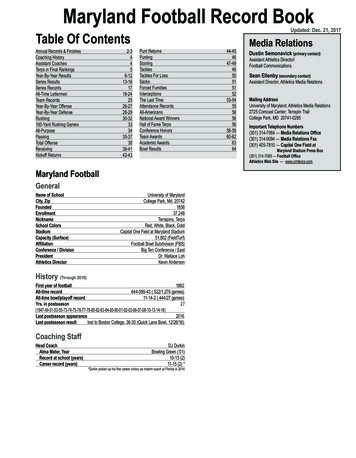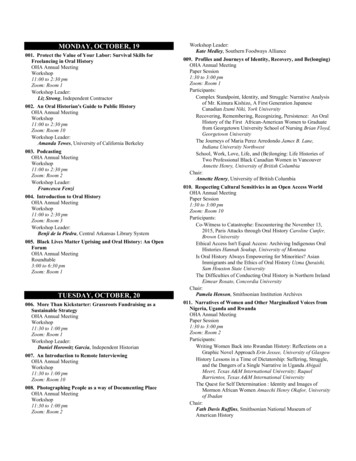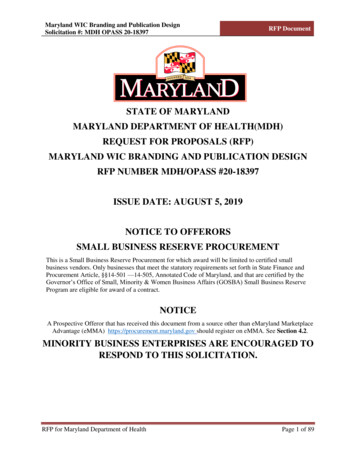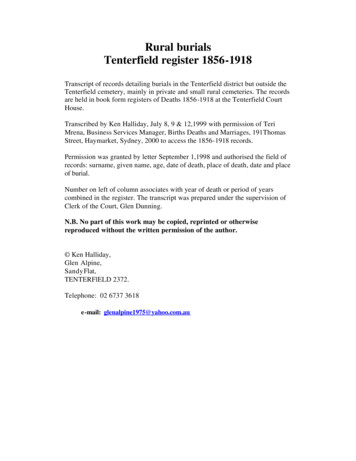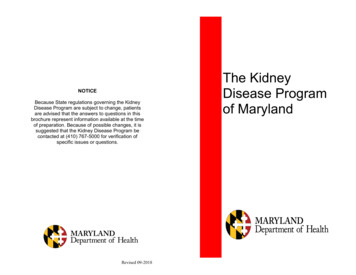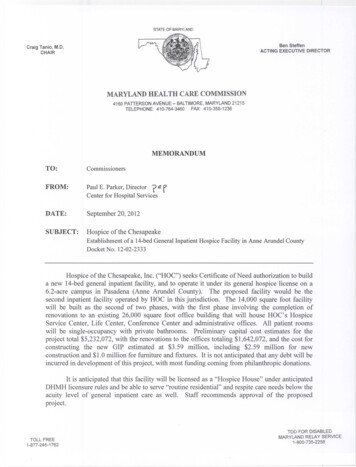
Transcription
IN THE MATTER OFHOSPICE OF THECHESAPEAKE, INC.DOCKET NO. 12-02-2333*******BEFORE THEMARYLAND HEALTHCARE **********Staff Report and RecommendationSeptember 20, 2012
I.INTRODUCTIONBackground and Project DescriptionHospice of the Chesapeake, Inc. (“HOC”) is a general hospice serving residents of AnneArundel County and Prince George’s County. A “general hospice program” is, under Marylandregulations, a “coordinated, interdisciplinary program of hospice care services designed to meetthe special physical, psychological, spiritual, and social needs of dying individuals and theirfamilies, by providing palliative and supportive medical, nursing, and other health-relatedservices during illness and bereavement through home or inpatient care.”HOC is the largest provider of hospice services in Anne Arundel County, serving 85% ofthe patients in this jurisdiction. It is the second-largest provider in Prince George’s County,serving 26% of the hospice demand in this jurisdiction in 2010 as reported in MHCC’s HospiceSurvey. Founded in 1979 as “Arundel Hospice,” it has operated as “Hospice of the Chesapeake”for the past eleven years. It has provided hospice care in patients’ homes, nursing homes,assisted living facilities, and area hospitals and, in recent years, has operated residential hospicefacilities, one of which is authorized to provide general inpatient hospice services; the Creston G.& Betty Jane Tate Foundation Chesapeake Hospice House (Tate Hospice House) in Linthicum (8residential beds) and the John & Arloine Mandrin Inpatient Care Center (“MICC”) in Harwood.The 8-bed MICC was opened in September 2011, and is staffed and equipped to provide generalinpatient (“GIP”) care to patients who would otherwise require hospitalization for symptommanagement. MICC is the only GIP hospice facility in the two-county service area. Neitherfacility is currently licensed as a health care facility under Maryland regulations, although theMaryland Department of Health and Mental Hygiene is currently developing licensureregulations for facilities of this type.HOC seeks Certificate of Need (“CON”) authorization to build a new 14-bed GIPfacility, and to operate it under its general hospice license on a 6.2-acre campus in Pasadena. 1As with MICC, this will allow HOC to bill Medicare and other third party payors for inpatienthospice care. “Inpatient care services” are defined in State regulation as “services provided by ageneral hospice care program for the purpose of pain control, symptom management, or respite.”This is generally consistent with Medicare criteria for GIP but federal regulations stipulate thatthe pain control and symptom management must be such that it cannot be provided outside of aninpatient setting. Also similar to MICC, HOC intends to dedicate the new beds primarily to GIPcare, with the understanding that it may occasionally use the beds for residential or respite careas demands dictate.The new 14,000 square foot inpatient treatment facility will be built as the second phaseof the new campus development, following completion of renovations to an existing 26,000square foot office building that will house its Hospice Service Center, Life Center, ConferenceCenter and administrative offices later this year. HOC states that all necessary land use1A “health care facility” regulated under the Maryland CON program is required to obtain CON approval to“change” its “bed capacity.” [Health-General Article § 19-120(h)]2
approvals and all required utilities are currently in place for the new GIP unit. The need for asecond GIP facility on the campus is anticipated, and architectural drawings for a 14-bedaddition, which would be connected to, and a mirror-image of, the proposed facility, have beenprovided. All patient rooms are single-occupancy with private bathrooms. Preliminary capitalcost estimates for the project total 5,232,072, with the renovations to the offices totaling 1,642,072, and the cost for constructing the new GIP facility estimated at 3.59 million,including 2.59 million for new construction and 1.0 million for furniture and fixtures. Themajority of funds for the project are projected to be raised through a capital campaign(approximately 4,132,072). The balance of project funding is anticipated to come through astate bond bill ( 600,000) and through a dedicated donation ( 500,000). HOC expects toobligate this capital expenditure within 18 months of CON approval, and anticipates an 8-monthconstruction timetable.Summary of Staff RecommendationStaff’s review of the proposed project’s compliance with the applicable State Health Plancriteria and standards in COMAR 10.24.08.14, State Health Plan: Hospice Services, and theremaining criteria at COMAR 10.24.01.08G(3) supports a recommendation of APPROVAL ofthe project.II.PROCEDURAL HISTORYA. Review of the RecordHospice of the Chesapeake submitted a letter of intent for this project on September 12,2011. Staff acknowledged receipt of the letter of intent on September 21, 2011 (Docket Item[“D.I.”] #1).On February 29, 2012, the Honorable Pamela G. Beidle, the Delegate from LegislativeDistrict 32 representing Anne Arundel County and on March 6, 2012, Karen E. Olscamp,FACHE, President and Chief Executive Officer of Baltimore Washington Medical System, eachsubmitted a letter of support for the Hospice of the Chesapeake’s CON application (D.I. #2)On March 13, 2012, Hospice of the Chesapeake filed a CON application (D.I. #3) and itwas assigned Matter No. 12-02-2333.On March 20, 2012, staff acknowledged receipt of the CON application. (D.I. # 4). Onthat same day, staff requested that The Capital, the Maryland Gazette, and the MarylandRegister publish notice of receipt of the application. (D.I. #s 5-7).On March 28, 2012, The Capital and the Maryland Gazette sent confirmation regardingpublication of the notice of receipt for the application. (D.I. # 8).On April 10, 2012, staff asked completeness questions (D.I. # 9).3
On April 24, 2012, Hospice of the Chesapeake filed the response to completenessquestions (D.I. #10).On June 4, 2012, staff requested the Maryland Register publish notice of the docketing ofthe application. (D.I. #11) On June 18 2012, staff requested that the Baltimore Sunpaper (D.I.#12) and the Maryland Gazette (D.I. #13) publish notice of docketing of the application.On June 8, 2012, staff submitted a request for review and comment, along with a copy ofthe application, to the Anne Arundel County Health Department (D.I. #14).On June 26, 2012, the Baltimore Sunpaper submitted confirmation regarding thepublication on the notice of docketing. (D.I. #15)On June 27, 2012, the Maryland Gazette submitted proof of publication regarding noticeof docketing on the notice of docketing for the CON application (D.I. #16).B. Interested PartiesThere are no interested parties in this review.C. Letters of Support and CommentsThe applicant provided letters of support for this project from the following persons:1. Delegate Pamela G. Beidle, 32nd Legislative District representing Anne ArundelCounty2. Victoria W. Bayless, President and CEO, Anne Arundel Medical Center3. Karen E. Olscamp, FACHE, President and Chief Executive Officer, BaltimoreWashington Medical System4. Reverend Dr. James G. Kirk, Chairman of the Board, Hospice of the Chesapeake, Inc.5. Mark Powell, Board Member, Hospice of the Chesapeake, Inc. and CEO, ARGOSystems, LLC6. M. Kathleen Sulick, Board Member, Hospice of the Chesapeake, Inc.III. DEMOGRAPHIC BACKGROUNDService Area PopulationThe applicant defines the service area for this project as serving Anne Arundel and PrinceGeorge’s Counties.The Maryland Department of Planning projects that the rate of total population growth inAnne Arundel and Prince George’s Counties will be lower than the state average over the next30 years. Both jurisdictions are expected to see substantial growth in their elderly populations.Hospice care is a service predicted to experience growth in demand, primarily originating in theelderly population, which will “boom” over the next 20 years.4
Table 1: Trends in Population by Age Group,Anne Arundel and Prince George’s Counties, and State of Maryland, CY 2010 - 2040Anne Arundel 85 %20202030203020402.46%Prince George's 83%69.32%24.84%220.94%85 2%2020203020302040201020202030State of %46.02%3.78%136.30%18.85%85 TotalSource: Maryland Department of Planning: Total Population Projections by Age, Sex and Race, March 2012Hospice Programs in Anne Arundel and Prince George’s CountiesAnne Arundel County is served by nine (9) general hospice providers. The programsoperating in this county include: Community Hospice of Maryland; Evercare Hospice andPalliative Care; Gilchrist Hospice Care; Heartland Hospice Services (Baltimore); HOC; JosephRichey House & Dr. Bob’s Place; Professional Healthcare Resources of Baltimore; SeasonsHospice & Palliative Care of Maryland; and Stella Maris, Inc. HOC is the only hospiceproviding inpatient hospice service facilities operated under its own license that are located inAnne Arundel County.Prince George’s County is also served by nine (9) general hospice providers. Theprograms operating in this county include: Capital Hospice, Inc.; Community Hospice ofMaryland; Evercare Hospice and Palliative Care; Gilchrist Hospice Care; Heartland Hospice –5
Beltsville; Holy Cross Hospice; HOC; Joseph Richey House & Dr. Bob’s Place; and SeasonsHospice & Palliative Care of Maryland.The following table provides the total number of Anne Arundel and Prince George’sCounty patients served by a hospice from 2008 to 2010. Both counties show an increase in thenumber of patients utilizing hospice services in 2010.Table 2: Hospice Patients and Proportion of Maryland’s Total Hospice PatientsAnne Arundel County and Prince George’s County, CY 2008 - 20102008JurisdictionAnne ArundelPrince ,9603.0%-6.8%8.6%1,76114.1%5.4%100.0%20,5258.2%% TotalPatientsNumber% 3% TotalPatientsSource: MHCC Hospice SurveyIV. PROJECT CONSISTENCY WITH REVIEW CRITERIAA. STATE HEALTH PLANCOMAR 10.24.01.08G(3)(a) State Health Plan. An application for a Certificate of Need shallbe evaluated according to all relevant State Health Plan standards, policies, and criteria.The applicable section of the State Health Plan (“SHP”) for this review is COMAR10.24.08, the State Health Plan for Facilities and Services: Nursing Home, Home Health Agency,and Hospice Services. The specific standards to be addressed are found at COMAR 10.24.08.14,Hospice Standards.COMAR 10.24.08.14: Hospice Standards. The Commission uses the following standards toreview Certificate of Need proposals to establish new general hospice program or expand theservice of an existing hospice program to additional jurisdictions. The current SHP does notcontain standards specifically addressing GIP services.A. Service Area. An applicant shall designate the jurisdiction in which it proposes to provideservices.HOC is a general hospice currently licensed to serve Anne Arundel and Prince George’scounties, which together constitute the proposed service area for the project. Each county isserved by a total of 9 general hospice programs. As previously noted, two hospice facilityprograms operate in the service area, both operated by HOC; the Tate Hospice House inLinthicum (8 residential beds) and MICC, in Harwood (8 general inpatient beds). The applicanthas complied with this standard.6
B. Admission Criteria. An applicant shall identify:1) Its admission criteria; and2) Proposed limits by age, disease or caregiver.HOC states that “the GIP unit will provide short-term medical crisis intervention forhospice patients who require pain control or symptom management that cannot be provided in ahome-care setting” and cites the criteria governed by the Centers for Medicare and MedicaidServices (CMS) for GIP services as its admission guidelines. No limitations based either uponage, disease or caregiver are noted by the applicant.The application is consistent with this standard.C. Minimum Services.1)An applicant shall provide the following services directly:a) Physician services and medical direction;b) Skilled nursing care;c) Counseling or social work;d) Spiritual services;e) Nutritional counseling; andf) On-call nursing responseThe applicant has confirmed that it directly provides the listed services, and is compliantwith this standard.2)An applicant shall also provide the following services, either directly or throughcontractual arrangements:a) Personal care;b) Volunteer services;c) Bereavement servicesd) Pharmacy services;e) Laboratory, radiology, and chemotherapy services as needed for palliative care;f) Medical supplies and equipment; andg) Special therapies, such as physical therapy, occupational therapy, speechtherapy, and dietary services.The applicant states that it provides, either directly or indirectly, all of the listed services.The project is consistent with this standard.3)An applicant shall provide bereavement services to the family for a period of at leastone year following the death of the patient.The applicant notes that bereavement services are available for a period of at least 13months following the death of a patient, exceeding the standard.7
D. Setting. An applicant shall specify where hospice services will be delivered: in a privatehome; a residential unit; an inpatient unit; or a combination of settings.The applicant has specified that GIP services will be provided in the proposed facility,consistent with this standard.E. Volunteers. An applicant shall have available sufficient trained caregiving volunteers tomeet the needs of patients and families in the hospice program.Volunteers trained in the care of hospice patients and bereavement are members of theHOC care team, and provide non-medical support for patients and family members. HOC is alicensed and Medicare-certified hospice. HOC projects the ability to have sufficient numbersand commits to provide appropriate training to volunteers to meet the needs of GIP patients. Theproposed project is consistent with this standard.F. Caregivers. An applicant shall provide, in a patient’s residence, appropriate instructionto, and support for, persons who are primary caretakers for a hospice patient.This standard is not directly applicable to this project proposal. While HOC is a providerof hospice services in patients’ residences and, in that role, states that it currently providesappropriate instruction and support for primary care givers, the proposal before the Commissionis the creation of a GIP facility that will deliver services outside of the patient’s residence.G. Financial Accessibility. An applicant shall be licensed and Medicare-certified, and agreeto accept clients whose expected primary source of payment is Medicare or Medicaid.HOC is both licensed and Medicare-certified, and will accept both Medicare andMedicaid patients in its GIP service. The Payment for Services policy, a copy of which wasprovided by HOC, states that HOC “shall accept appropriate patients and their familiesregardless of their ability to pay for services.” The project is consistent with this standard.H. Information to Providers and the General Public.1)General Information. An applicant shall inform the following entities about theprogram’s services, service area, reimbursement policy, office location, andtelephone number:a) All hospitals, nursing homes, and assisted living providers within its proposedservice area;b) At least five physicians who practice in its proposed service area;c) The Senior Information and Assistance Offices located in its proposed servicearea; andd) The general public in its proposed service area.HOC notes that it “maintains a team of professionals who are responsible for educatingthe medical community on the programs and services it offers.” The proposal is considered to beconsistent with the standard. MHCC has calculated that Anne Arundel County experienced a“hospice use rate” (hospice deaths/population deaths) of 0.44 in 2010, among the highest in the8
state, which indicates that HOC, the jurisdictions dominant hospice service provider, may beeffective in providing information to its service area population. The 2010 hospice use rate forPrince George’s County residents, as calculated by MHCC, was 0.23. The project is consistentwith this standard.2)Fees. An applicant shall make its fees known to clients and their families beforeservices are begun.HOC’s current daily fees for general hospice care are identified in its Payment forServices and Requests for Charitable Adjustments policy, a copy of which was provided. Thepolicy does not address fees for general inpatient care; however, the HOC Private InsuranceFinancial Plan form, indicates that the current daily rate is equal to the CMS rate which is 698.33. The Payment for Services policy states that payments received from Medicare orMedicaid will be considered payment in full for care provided. The project is consistent withthis standard.I.Time Payment Plan. An applicant shall:1) Establish special time payment plans for individuals unable to make full payment atthe time services are rendered; and2) Submit to the Commission and to each client a written copy of its policy detailingtime payment options and mechanisms for clients to arrange for time payment.HOC’s Payment for Services and Requests for Charitable Adjustments policy is providedto, and discussed with, patients and their families prior to admission. The policy states “Whennecessary and determined feasible, Hospice of the Chesapeake will use extended payments or aclaim on an estate for the payment for hospice services.” The applicant is consistent with thisstandard.J. Charity Care and Sliding Fee Scale. Each applicant for hospice services shall have awritten policy for the provision of charity care for uninsured and under-insured patients topromote access to hospice services regardless of an individual’s ability to pay. The policyshall include provisions for, at a minimum, the following:1) Provide documentation of financial estimates of the amount of charity care thatit intends to provide annually;2) Provide documentation of a written policy for the provision of complete andpartial charity care for indigent and other persons unable to pay for services;3) Provide documentation of a written policy for the provision of sliding fee scalesfor clients unable to bear the full cost of services;4) Provide a written copy of its charity care and sliding fee scale policies to eachclient before serves are begun;5) Provide documentation that an individual notice of charity care is provided toeach person who seeks services in the hospice program; and6) Make a determination of probable eligibility for charity care and/or reduced feeswithin two business days of the client’s initial request.9
HOC’s proposed budgets for FY 2015 and 2016 project charity care provision equivalentto 5% of gross inpatient revenues, amounting to 117,288 and 153,233, respectively, in charitycare for GIP patients in the first two full years of operation for the program.The applicant has provided a complete set of policies, procedures, notices, applicationforms and contracts covering charity care and sliding fee arrangements, which are provided to allpatients and families at the time of admission. The policy provides that the determination ofeligibility for charitable adjustment of fees will be made within two days of request forconsideration, satisfying the requirements of this standard.K. Quality. An applicant shall document ongoing compliance with all federal and statequality of care standards.HOC is licensed and Medicare-certified in good standing, attesting to its compliance withthis standard.L. Linkages with Other Service Providers.1)2)An applicant shall identify how inpatient care will be provided to patients, eitherdirectly, or through a contract with an inpatient provider that ensures continuity ofpatient care.An applicant shall agree to document, before licensure, that is has established linkswith hospitals, nursing homes, home health agencies, assisted living providers,Adult Evaluation and Review Services (AERS), Senior Information and Assistance,adult day care programs, the local Department of Social Services, and homedelivered meal programs located within its proposed service area.The project will provide GIP services directly through its nursing staff in the proposed14-bed facility. The applicant states that, where necessary, HOC will utilize its establishedcontractual relationships with other health care providers in Anne Arundel County to provideadditional services, satisfying this standard.M.Respite Care. An applicant shall document its system for providing respite care for thefamily and other caregivers of clients.HOC states that “the GIP unit will provide respite care which will be billed at theappropriate rates.” HOC indicates that the daily rate for respite care is 164.44. The project isconsistent with the standard.N.Public Education Programs. An applicant shall document its plan to provide publiceducation programs designed to increase awareness and consciousness of the needs ofdying people and their caregivers.HOC’s Life Center provides an extensive array of public education and outreachprograms for the community at large. The applicant notes that the proposed GIP unity will haveaccess to, and benefit from, all of the educational programs offered by HOC. The proposal isconsistent with this standard.10
O.Patients’ Rights. An applicant shall document its compliance with the patients’ rightsrequirements of COMAR 10.07.21.21.HQA has provided a copy of its Statement of Patient and Family Rights andResponsibilities, which includes each of the 12 rights enumerated in COMAR 10.04.21.21. This,and other related policies including Patient Self Determination, Primary CaregiverResponsibilities and the Patient/Hospice Agreement are provided to, and discussed with, thepatient and family members during the admission process. The project complies with thisstandard.PART TWO: REMAINING CERTIFICATE OF NEED REVIEW CRITERIAThe project’s compliance with the five remaining general review criteria in theRegulations governing Certificate of Need is assessed below:B. NEEDCOMAR 10.24.01.08G(3)(b) Need. The Commission shall consider the applicable needanalysis in the State Health Plan. If no State Health Plan need analysis is applicable, theCommission shall consider whether the applicant has demonstrated unmet needs of thepopulation to be served, and established that the proposed project meets those needs.In the absence of quantitative need analysis methodologies in the State Health Plan, theapplicant has provided an assessment of the unmet need for GIP services for its hospice patientsin Anne Arundel and Prince George’s counties who require acute medical care. This assessmentis summarized and discussed below.HOC cites data provided through the National Hospice and Palliative Care Organizationrevealing that demand for hospice services nationally has grown at an annual rate of 4% since2007, a pace identical to the average annual growth in patients served by HOC since 2009.Despite the very rapid historical and anticipated growth rate of the elderly population, and thegrowth in acceptance of hospice care generally, the applicant has conservatively estimated thatthis annual rate of growth in demand its for services will remain flat at 4% for the purposes ofprogram planning. Table 3 below shows historical and projected overall utilization of HOC’sservices from 2009 to 2016.2009Table 3: HOC Historical and Projected Utilization2009-2016Avg. Annual % Change2010 20112012 20132009-2011Total Patients1,881 1,917 2,037ServedSource: Historical data from HOC records 4%2,1182,2032014201520162,2912,3832,478The applicant anticipates that 38% of all patients served annually by HOC will receive GIPcare in its dedicated facilities each year. This is equivalent to the experience of the seven other11
hospices in Maryland that report availability of GIP services operated under their general hospicelicense. The table below shows the utilization experience of these hospice inpatient facilities.CarrollCoastalGilchristJoseph RicheyMontgomerySeasonsStella MarisTotal – All GIPTable 4: Inpatient Use Rates for Maryland Hospice GIP %63%30%27%53%38%Source: MHCC Hospice Survey, 2009 and 2010While this percentage is significantly higher than the 22.4% of HOC’s patients whoreceive acute care in contracted general hospital beds currently, the applicant explains that theprospect of admission to an ordinary acute care hospital facility has proven to be veryunattractive to patients who have chosen to die at home, or in a home-like environment. Staffnotes that the target GIP utilization rate of 38% is similar to the 40% rate projected by Hospiceof Queen Anne’s, whose GIP proposal was reviewed and approved recently by the Commission,based upon its review of the clinical appropriateness for such care using the Centers forMedicare and Medicaid Services admission criteria.Applying the 38% benchmark of demand for GIP services to the projected overallvolume of patients from Table 4, the applicant estimates that 805 patients will utilize GIPservices in 2012, with the number increasing to 942 patients in 2016.HOC has used a target average length of stay (ALOS) of 7.0 days for its proposed GIPprogram. This duration of treatment is somewhat longer than the 6.1 day ALOS experienced inits Mandrin Center during the first 7 months of its operation, but less than the average ofdedicated GIP programs in Maryland, as shown in the table below.The lengths of stay calculated in Table 5 are clearly skewed by the data reported by theJoseph Richey House in Baltimore, and removing this outlier from the ALOS calculations for2009 and 2010 would result in mean lengths of stay of 6.6 and 6.4 days, respectively. Theapplicant addresses this issue by stating that it has targeted its ALOS based upon the experiencesof Montgomery Hospice and Gilchrist Hospice, as these two non-profit programs are mostsimilar to HOC in terms of service area demographics, overall size and patterns of care. Thesetwo GIP programs’ ALOS averaged 7.0 days in 2010.Table 5: Average Lengths of Stay in Maryland Hospice GIP Programs2009-201012
2009InpatientsGIP ,5291,116Joseph lla Maris2,451503Total – All GIP28,3513,632Source: MHCC Hospice Survey, 2009 and 2010ALOS4.17.17.633.27.96.24.97.8GIP 6.56.549.07.57.25.18.0Finally, the applicant used a target occupancy rate of 85% for the purposes of projectingthe demand for GIP beds for its patients. Applying the projected ALOS and occupancy rates tothe expected inpatient volume, the applicant calculates the following need for GIP beds in itsservice area by 2016.Table 6: Calculated GIP Bed Need, HOC Service Area2016Forecast Patient DaysGIPGIPAt 7.0 DayAvg. Daily Bed Need at 85%VolumeALOSCensusBed OccupancyAnne Arundel County7455,21514.316.8Prince George’s County1971,3793.84.5Total9426,59418.121.3Source: Application; calculations corrected by MHCC staffHOC has rounded up the calculated need to 22 beds, citing its desire to be certain ofmeeting its patients’ needs. Since the service area currently has an inventory of 8 GIP bedsoperated at HOC’s MICC, the applicant concludes that a net unmet need for 14 GIP beds existsin Anne Arundel and Prince George’s counties.Responding to MHCC staff’s request, HOC has provided utilization data for its MandrinCenter from its opening in mid-September 2011 to mid-April 2012. During this roughly 7 monthramp-up period, the GIP program has treated a total of 137 patients for a total of 836 patientdays, achieving an average daily occupancy of nearly 50%, using an estimated 1,702 possibledays of care (7 months x 30.4 days per month x 8 beds).The applicant has provided a reasonable needs assessment for the proposed project. Theproposed facility, like the existing Mandrin Center, is intended to accommodate patients needingGIP services but both will have the flexibility to also be used for respite care, as needed, and forroutine hospice care, below the GIP acuity level, if a bed is needed for these purposes.Overflow in demand for routine hospice care can be accommodated and may be needed, basedon waiting list that have been experience
A "general hospice program" is, under Maryland . nursing, and other healthrelated - services during illness and bereavement through home or inpatient care." HOC is the largest provider of hospice services in Anne Arundel County, serving 85% of . Anne Arundel and Prince George's Counties will be lower than the state average over the .





